Pathophysiology and Management of Heart Failure Report
VerifiedAdded on 2022/10/12
|7
|2149
|240
Report
AI Summary
This report delves into the complexities of chronic systolic heart failure and its acute exacerbation, providing a comprehensive overview of the underlying pathophysiology. It examines the causes, clinical manifestations, and diagnostic procedures associated with the condition. The report emphasizes evidence-based nursing strategies for managing patients experiencing an acute exacerbation, including interventions for breathlessness and atrial fibrillation. Furthermore, it elucidates the mechanisms of action of key medications, specifically IV furosemide and sublingual glyceryl trinitrate, commonly used in heart failure treatment. The report aims to provide a detailed understanding of the disease process and effective management approaches, supported by relevant research and clinical guidelines, as contributed by a student and published on Desklib, a platform designed to provide AI based study tools for students.
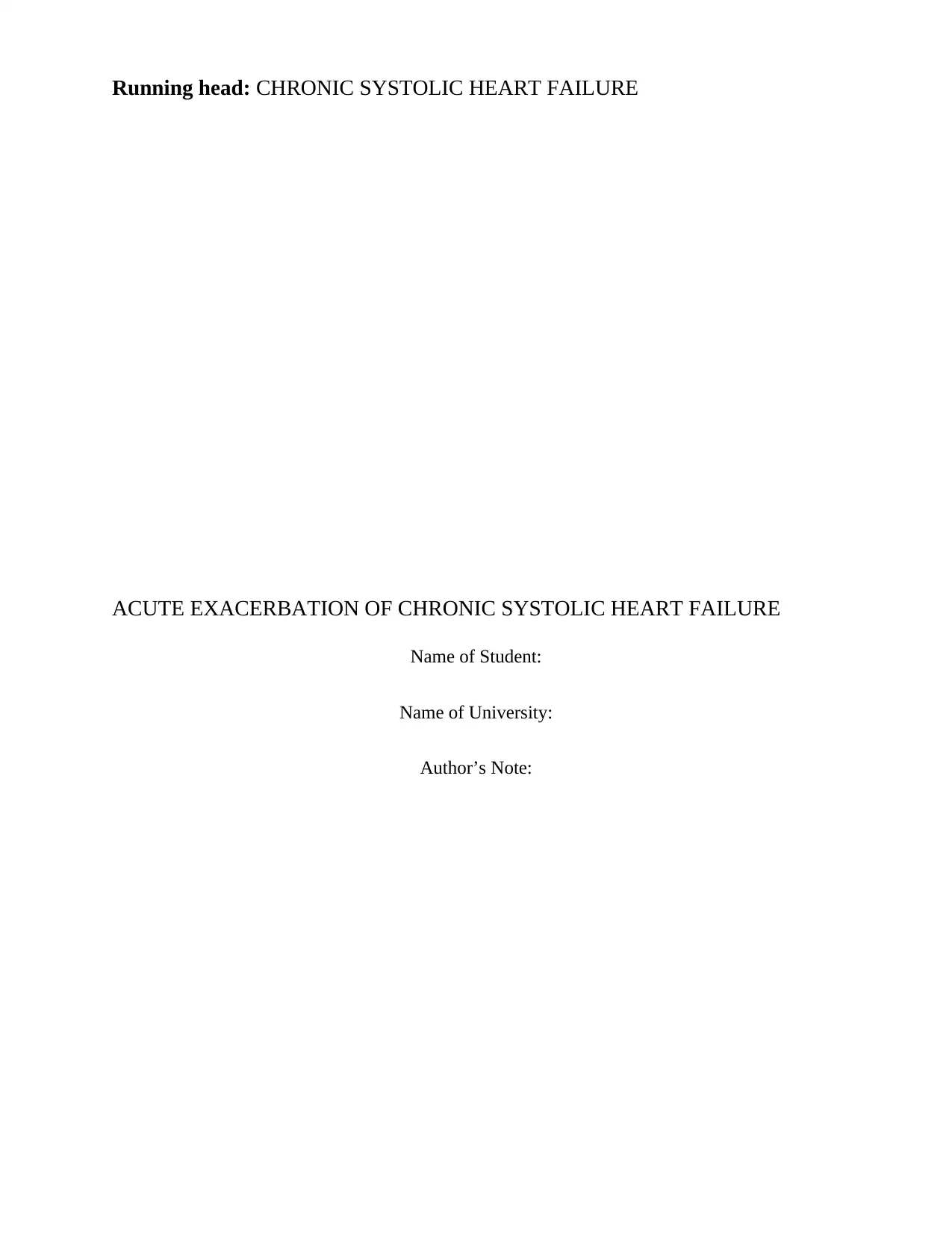
Running head: CHRONIC SYSTOLIC HEART FAILURE
ACUTE EXACERBATION OF CHRONIC SYSTOLIC HEART FAILURE
Name of Student:
Name of University:
Author’s Note:
ACUTE EXACERBATION OF CHRONIC SYSTOLIC HEART FAILURE
Name of Student:
Name of University:
Author’s Note:
Paraphrase This Document
Need a fresh take? Get an instant paraphrase of this document with our AI Paraphraser
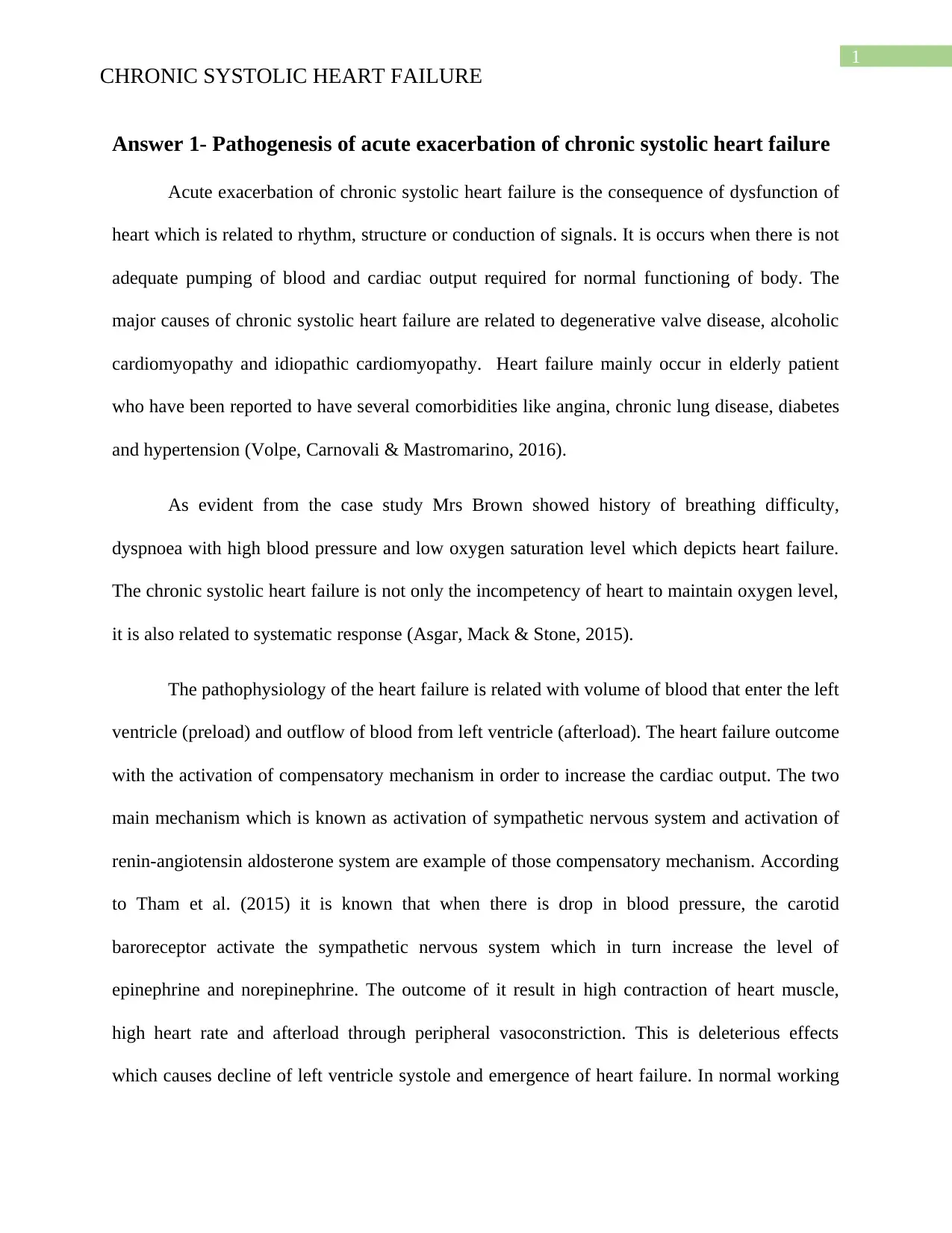
1
CHRONIC SYSTOLIC HEART FAILURE
Answer 1- Pathogenesis of acute exacerbation of chronic systolic heart failure
Acute exacerbation of chronic systolic heart failure is the consequence of dysfunction of
heart which is related to rhythm, structure or conduction of signals. It is occurs when there is not
adequate pumping of blood and cardiac output required for normal functioning of body. The
major causes of chronic systolic heart failure are related to degenerative valve disease, alcoholic
cardiomyopathy and idiopathic cardiomyopathy. Heart failure mainly occur in elderly patient
who have been reported to have several comorbidities like angina, chronic lung disease, diabetes
and hypertension (Volpe, Carnovali & Mastromarino, 2016).
As evident from the case study Mrs Brown showed history of breathing difficulty,
dyspnoea with high blood pressure and low oxygen saturation level which depicts heart failure.
The chronic systolic heart failure is not only the incompetency of heart to maintain oxygen level,
it is also related to systematic response (Asgar, Mack & Stone, 2015).
The pathophysiology of the heart failure is related with volume of blood that enter the left
ventricle (preload) and outflow of blood from left ventricle (afterload). The heart failure outcome
with the activation of compensatory mechanism in order to increase the cardiac output. The two
main mechanism which is known as activation of sympathetic nervous system and activation of
renin-angiotensin aldosterone system are example of those compensatory mechanism. According
to Tham et al. (2015) it is known that when there is drop in blood pressure, the carotid
baroreceptor activate the sympathetic nervous system which in turn increase the level of
epinephrine and norepinephrine. The outcome of it result in high contraction of heart muscle,
high heart rate and afterload through peripheral vasoconstriction. This is deleterious effects
which causes decline of left ventricle systole and emergence of heart failure. In normal working
CHRONIC SYSTOLIC HEART FAILURE
Answer 1- Pathogenesis of acute exacerbation of chronic systolic heart failure
Acute exacerbation of chronic systolic heart failure is the consequence of dysfunction of
heart which is related to rhythm, structure or conduction of signals. It is occurs when there is not
adequate pumping of blood and cardiac output required for normal functioning of body. The
major causes of chronic systolic heart failure are related to degenerative valve disease, alcoholic
cardiomyopathy and idiopathic cardiomyopathy. Heart failure mainly occur in elderly patient
who have been reported to have several comorbidities like angina, chronic lung disease, diabetes
and hypertension (Volpe, Carnovali & Mastromarino, 2016).
As evident from the case study Mrs Brown showed history of breathing difficulty,
dyspnoea with high blood pressure and low oxygen saturation level which depicts heart failure.
The chronic systolic heart failure is not only the incompetency of heart to maintain oxygen level,
it is also related to systematic response (Asgar, Mack & Stone, 2015).
The pathophysiology of the heart failure is related with volume of blood that enter the left
ventricle (preload) and outflow of blood from left ventricle (afterload). The heart failure outcome
with the activation of compensatory mechanism in order to increase the cardiac output. The two
main mechanism which is known as activation of sympathetic nervous system and activation of
renin-angiotensin aldosterone system are example of those compensatory mechanism. According
to Tham et al. (2015) it is known that when there is drop in blood pressure, the carotid
baroreceptor activate the sympathetic nervous system which in turn increase the level of
epinephrine and norepinephrine. The outcome of it result in high contraction of heart muscle,
high heart rate and afterload through peripheral vasoconstriction. This is deleterious effects
which causes decline of left ventricle systole and emergence of heart failure. In normal working
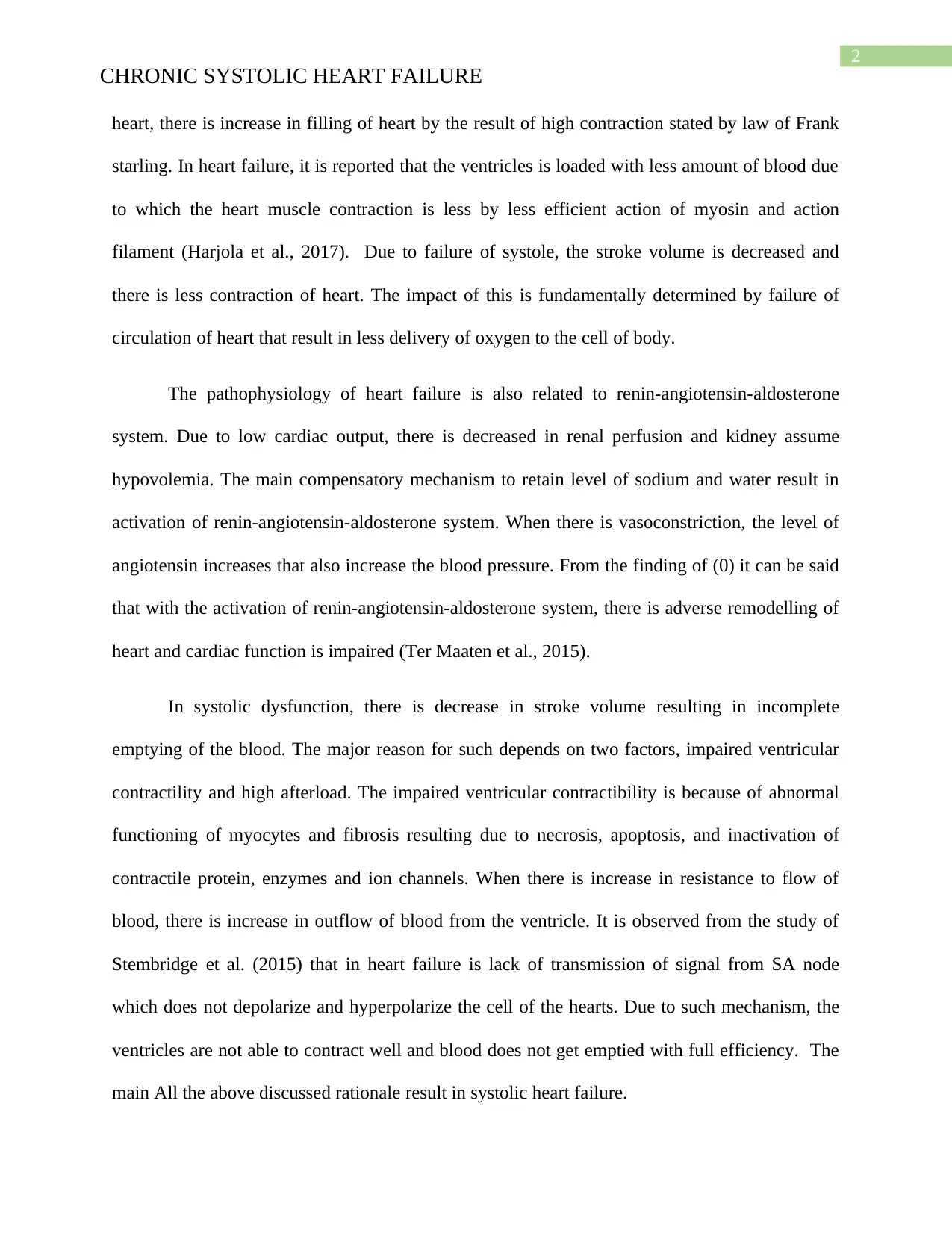
2
CHRONIC SYSTOLIC HEART FAILURE
heart, there is increase in filling of heart by the result of high contraction stated by law of Frank
starling. In heart failure, it is reported that the ventricles is loaded with less amount of blood due
to which the heart muscle contraction is less by less efficient action of myosin and action
filament (Harjola et al., 2017). Due to failure of systole, the stroke volume is decreased and
there is less contraction of heart. The impact of this is fundamentally determined by failure of
circulation of heart that result in less delivery of oxygen to the cell of body.
The pathophysiology of heart failure is also related to renin-angiotensin-aldosterone
system. Due to low cardiac output, there is decreased in renal perfusion and kidney assume
hypovolemia. The main compensatory mechanism to retain level of sodium and water result in
activation of renin-angiotensin-aldosterone system. When there is vasoconstriction, the level of
angiotensin increases that also increase the blood pressure. From the finding of (0) it can be said
that with the activation of renin-angiotensin-aldosterone system, there is adverse remodelling of
heart and cardiac function is impaired (Ter Maaten et al., 2015).
In systolic dysfunction, there is decrease in stroke volume resulting in incomplete
emptying of the blood. The major reason for such depends on two factors, impaired ventricular
contractility and high afterload. The impaired ventricular contractibility is because of abnormal
functioning of myocytes and fibrosis resulting due to necrosis, apoptosis, and inactivation of
contractile protein, enzymes and ion channels. When there is increase in resistance to flow of
blood, there is increase in outflow of blood from the ventricle. It is observed from the study of
Stembridge et al. (2015) that in heart failure is lack of transmission of signal from SA node
which does not depolarize and hyperpolarize the cell of the hearts. Due to such mechanism, the
ventricles are not able to contract well and blood does not get emptied with full efficiency. The
main All the above discussed rationale result in systolic heart failure.
CHRONIC SYSTOLIC HEART FAILURE
heart, there is increase in filling of heart by the result of high contraction stated by law of Frank
starling. In heart failure, it is reported that the ventricles is loaded with less amount of blood due
to which the heart muscle contraction is less by less efficient action of myosin and action
filament (Harjola et al., 2017). Due to failure of systole, the stroke volume is decreased and
there is less contraction of heart. The impact of this is fundamentally determined by failure of
circulation of heart that result in less delivery of oxygen to the cell of body.
The pathophysiology of heart failure is also related to renin-angiotensin-aldosterone
system. Due to low cardiac output, there is decreased in renal perfusion and kidney assume
hypovolemia. The main compensatory mechanism to retain level of sodium and water result in
activation of renin-angiotensin-aldosterone system. When there is vasoconstriction, the level of
angiotensin increases that also increase the blood pressure. From the finding of (0) it can be said
that with the activation of renin-angiotensin-aldosterone system, there is adverse remodelling of
heart and cardiac function is impaired (Ter Maaten et al., 2015).
In systolic dysfunction, there is decrease in stroke volume resulting in incomplete
emptying of the blood. The major reason for such depends on two factors, impaired ventricular
contractility and high afterload. The impaired ventricular contractibility is because of abnormal
functioning of myocytes and fibrosis resulting due to necrosis, apoptosis, and inactivation of
contractile protein, enzymes and ion channels. When there is increase in resistance to flow of
blood, there is increase in outflow of blood from the ventricle. It is observed from the study of
Stembridge et al. (2015) that in heart failure is lack of transmission of signal from SA node
which does not depolarize and hyperpolarize the cell of the hearts. Due to such mechanism, the
ventricles are not able to contract well and blood does not get emptied with full efficiency. The
main All the above discussed rationale result in systolic heart failure.
⊘ This is a preview!⊘
Do you want full access?
Subscribe today to unlock all pages.

Trusted by 1+ million students worldwide
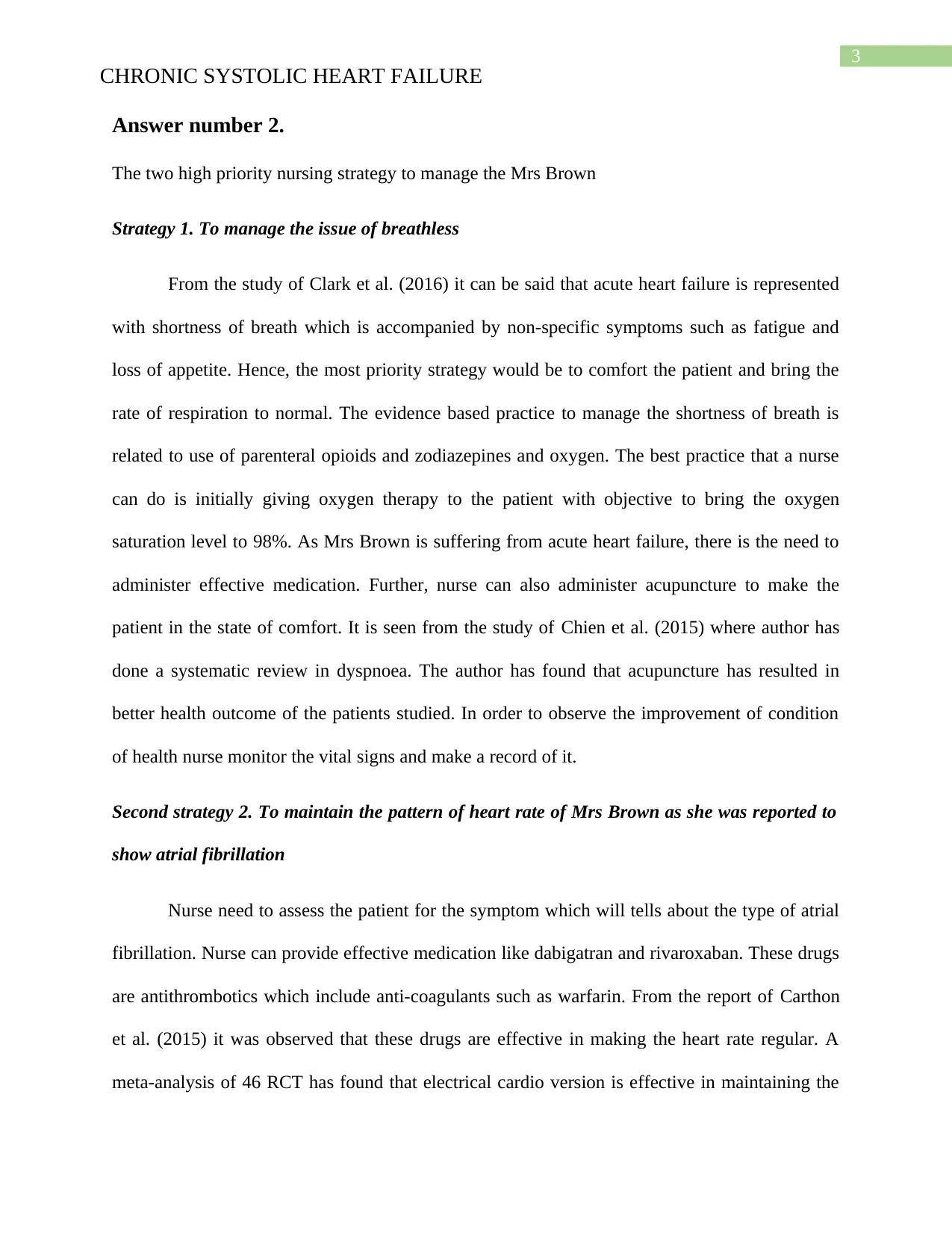
3
CHRONIC SYSTOLIC HEART FAILURE
Answer number 2.
The two high priority nursing strategy to manage the Mrs Brown
Strategy 1. To manage the issue of breathless
From the study of Clark et al. (2016) it can be said that acute heart failure is represented
with shortness of breath which is accompanied by non-specific symptoms such as fatigue and
loss of appetite. Hence, the most priority strategy would be to comfort the patient and bring the
rate of respiration to normal. The evidence based practice to manage the shortness of breath is
related to use of parenteral opioids and zodiazepines and oxygen. The best practice that a nurse
can do is initially giving oxygen therapy to the patient with objective to bring the oxygen
saturation level to 98%. As Mrs Brown is suffering from acute heart failure, there is the need to
administer effective medication. Further, nurse can also administer acupuncture to make the
patient in the state of comfort. It is seen from the study of Chien et al. (2015) where author has
done a systematic review in dyspnoea. The author has found that acupuncture has resulted in
better health outcome of the patients studied. In order to observe the improvement of condition
of health nurse monitor the vital signs and make a record of it.
Second strategy 2. To maintain the pattern of heart rate of Mrs Brown as she was reported to
show atrial fibrillation
Nurse need to assess the patient for the symptom which will tells about the type of atrial
fibrillation. Nurse can provide effective medication like dabigatran and rivaroxaban. These drugs
are antithrombotics which include anti-coagulants such as warfarin. From the report of Carthon
et al. (2015) it was observed that these drugs are effective in making the heart rate regular. A
meta-analysis of 46 RCT has found that electrical cardio version is effective in maintaining the
CHRONIC SYSTOLIC HEART FAILURE
Answer number 2.
The two high priority nursing strategy to manage the Mrs Brown
Strategy 1. To manage the issue of breathless
From the study of Clark et al. (2016) it can be said that acute heart failure is represented
with shortness of breath which is accompanied by non-specific symptoms such as fatigue and
loss of appetite. Hence, the most priority strategy would be to comfort the patient and bring the
rate of respiration to normal. The evidence based practice to manage the shortness of breath is
related to use of parenteral opioids and zodiazepines and oxygen. The best practice that a nurse
can do is initially giving oxygen therapy to the patient with objective to bring the oxygen
saturation level to 98%. As Mrs Brown is suffering from acute heart failure, there is the need to
administer effective medication. Further, nurse can also administer acupuncture to make the
patient in the state of comfort. It is seen from the study of Chien et al. (2015) where author has
done a systematic review in dyspnoea. The author has found that acupuncture has resulted in
better health outcome of the patients studied. In order to observe the improvement of condition
of health nurse monitor the vital signs and make a record of it.
Second strategy 2. To maintain the pattern of heart rate of Mrs Brown as she was reported to
show atrial fibrillation
Nurse need to assess the patient for the symptom which will tells about the type of atrial
fibrillation. Nurse can provide effective medication like dabigatran and rivaroxaban. These drugs
are antithrombotics which include anti-coagulants such as warfarin. From the report of Carthon
et al. (2015) it was observed that these drugs are effective in making the heart rate regular. A
meta-analysis of 46 RCT has found that electrical cardio version is effective in maintaining the
Paraphrase This Document
Need a fresh take? Get an instant paraphrase of this document with our AI Paraphraser
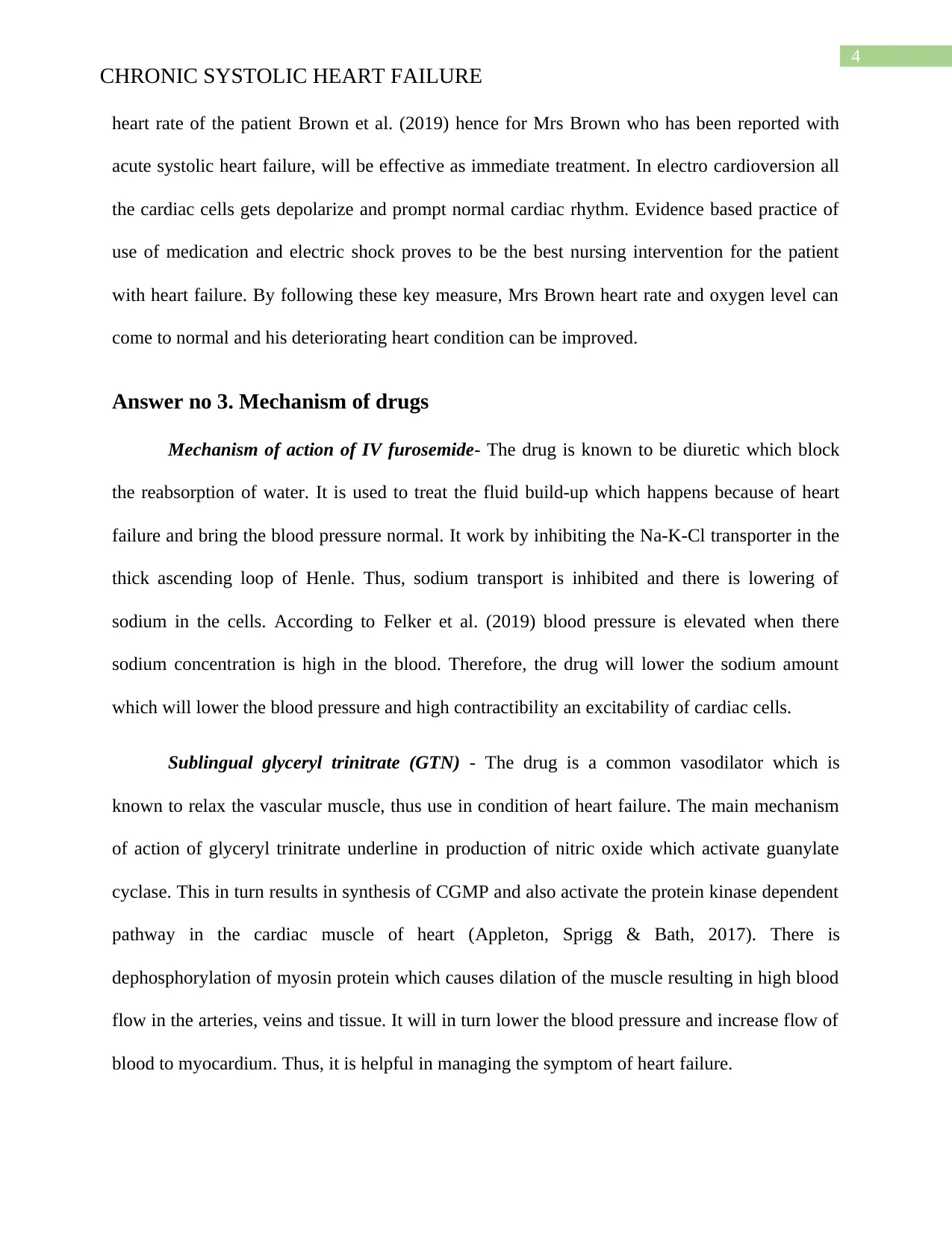
4
CHRONIC SYSTOLIC HEART FAILURE
heart rate of the patient Brown et al. (2019) hence for Mrs Brown who has been reported with
acute systolic heart failure, will be effective as immediate treatment. In electro cardioversion all
the cardiac cells gets depolarize and prompt normal cardiac rhythm. Evidence based practice of
use of medication and electric shock proves to be the best nursing intervention for the patient
with heart failure. By following these key measure, Mrs Brown heart rate and oxygen level can
come to normal and his deteriorating heart condition can be improved.
Answer no 3. Mechanism of drugs
Mechanism of action of IV furosemide- The drug is known to be diuretic which block
the reabsorption of water. It is used to treat the fluid build-up which happens because of heart
failure and bring the blood pressure normal. It work by inhibiting the Na-K-Cl transporter in the
thick ascending loop of Henle. Thus, sodium transport is inhibited and there is lowering of
sodium in the cells. According to Felker et al. (2019) blood pressure is elevated when there
sodium concentration is high in the blood. Therefore, the drug will lower the sodium amount
which will lower the blood pressure and high contractibility an excitability of cardiac cells.
Sublingual glyceryl trinitrate (GTN) - The drug is a common vasodilator which is
known to relax the vascular muscle, thus use in condition of heart failure. The main mechanism
of action of glyceryl trinitrate underline in production of nitric oxide which activate guanylate
cyclase. This in turn results in synthesis of CGMP and also activate the protein kinase dependent
pathway in the cardiac muscle of heart (Appleton, Sprigg & Bath, 2017). There is
dephosphorylation of myosin protein which causes dilation of the muscle resulting in high blood
flow in the arteries, veins and tissue. It will in turn lower the blood pressure and increase flow of
blood to myocardium. Thus, it is helpful in managing the symptom of heart failure.
CHRONIC SYSTOLIC HEART FAILURE
heart rate of the patient Brown et al. (2019) hence for Mrs Brown who has been reported with
acute systolic heart failure, will be effective as immediate treatment. In electro cardioversion all
the cardiac cells gets depolarize and prompt normal cardiac rhythm. Evidence based practice of
use of medication and electric shock proves to be the best nursing intervention for the patient
with heart failure. By following these key measure, Mrs Brown heart rate and oxygen level can
come to normal and his deteriorating heart condition can be improved.
Answer no 3. Mechanism of drugs
Mechanism of action of IV furosemide- The drug is known to be diuretic which block
the reabsorption of water. It is used to treat the fluid build-up which happens because of heart
failure and bring the blood pressure normal. It work by inhibiting the Na-K-Cl transporter in the
thick ascending loop of Henle. Thus, sodium transport is inhibited and there is lowering of
sodium in the cells. According to Felker et al. (2019) blood pressure is elevated when there
sodium concentration is high in the blood. Therefore, the drug will lower the sodium amount
which will lower the blood pressure and high contractibility an excitability of cardiac cells.
Sublingual glyceryl trinitrate (GTN) - The drug is a common vasodilator which is
known to relax the vascular muscle, thus use in condition of heart failure. The main mechanism
of action of glyceryl trinitrate underline in production of nitric oxide which activate guanylate
cyclase. This in turn results in synthesis of CGMP and also activate the protein kinase dependent
pathway in the cardiac muscle of heart (Appleton, Sprigg & Bath, 2017). There is
dephosphorylation of myosin protein which causes dilation of the muscle resulting in high blood
flow in the arteries, veins and tissue. It will in turn lower the blood pressure and increase flow of
blood to myocardium. Thus, it is helpful in managing the symptom of heart failure.
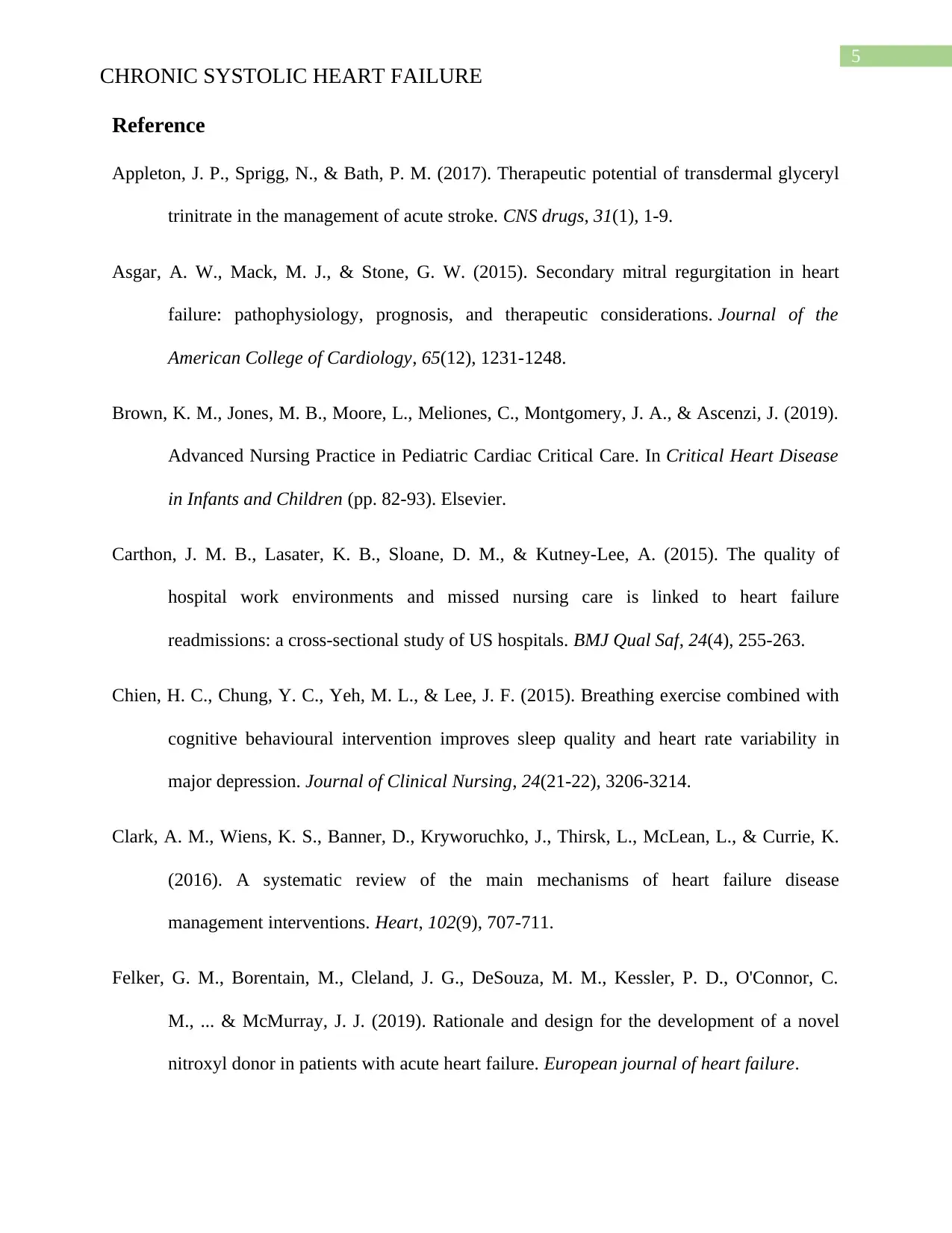
5
CHRONIC SYSTOLIC HEART FAILURE
Reference
Appleton, J. P., Sprigg, N., & Bath, P. M. (2017). Therapeutic potential of transdermal glyceryl
trinitrate in the management of acute stroke. CNS drugs, 31(1), 1-9.
Asgar, A. W., Mack, M. J., & Stone, G. W. (2015). Secondary mitral regurgitation in heart
failure: pathophysiology, prognosis, and therapeutic considerations. Journal of the
American College of Cardiology, 65(12), 1231-1248.
Brown, K. M., Jones, M. B., Moore, L., Meliones, C., Montgomery, J. A., & Ascenzi, J. (2019).
Advanced Nursing Practice in Pediatric Cardiac Critical Care. In Critical Heart Disease
in Infants and Children (pp. 82-93). Elsevier.
Carthon, J. M. B., Lasater, K. B., Sloane, D. M., & Kutney-Lee, A. (2015). The quality of
hospital work environments and missed nursing care is linked to heart failure
readmissions: a cross-sectional study of US hospitals. BMJ Qual Saf, 24(4), 255-263.
Chien, H. C., Chung, Y. C., Yeh, M. L., & Lee, J. F. (2015). Breathing exercise combined with
cognitive behavioural intervention improves sleep quality and heart rate variability in
major depression. Journal of Clinical Nursing, 24(21-22), 3206-3214.
Clark, A. M., Wiens, K. S., Banner, D., Kryworuchko, J., Thirsk, L., McLean, L., & Currie, K.
(2016). A systematic review of the main mechanisms of heart failure disease
management interventions. Heart, 102(9), 707-711.
Felker, G. M., Borentain, M., Cleland, J. G., DeSouza, M. M., Kessler, P. D., O'Connor, C.
M., ... & McMurray, J. J. (2019). Rationale and design for the development of a novel
nitroxyl donor in patients with acute heart failure. European journal of heart failure.
CHRONIC SYSTOLIC HEART FAILURE
Reference
Appleton, J. P., Sprigg, N., & Bath, P. M. (2017). Therapeutic potential of transdermal glyceryl
trinitrate in the management of acute stroke. CNS drugs, 31(1), 1-9.
Asgar, A. W., Mack, M. J., & Stone, G. W. (2015). Secondary mitral regurgitation in heart
failure: pathophysiology, prognosis, and therapeutic considerations. Journal of the
American College of Cardiology, 65(12), 1231-1248.
Brown, K. M., Jones, M. B., Moore, L., Meliones, C., Montgomery, J. A., & Ascenzi, J. (2019).
Advanced Nursing Practice in Pediatric Cardiac Critical Care. In Critical Heart Disease
in Infants and Children (pp. 82-93). Elsevier.
Carthon, J. M. B., Lasater, K. B., Sloane, D. M., & Kutney-Lee, A. (2015). The quality of
hospital work environments and missed nursing care is linked to heart failure
readmissions: a cross-sectional study of US hospitals. BMJ Qual Saf, 24(4), 255-263.
Chien, H. C., Chung, Y. C., Yeh, M. L., & Lee, J. F. (2015). Breathing exercise combined with
cognitive behavioural intervention improves sleep quality and heart rate variability in
major depression. Journal of Clinical Nursing, 24(21-22), 3206-3214.
Clark, A. M., Wiens, K. S., Banner, D., Kryworuchko, J., Thirsk, L., McLean, L., & Currie, K.
(2016). A systematic review of the main mechanisms of heart failure disease
management interventions. Heart, 102(9), 707-711.
Felker, G. M., Borentain, M., Cleland, J. G., DeSouza, M. M., Kessler, P. D., O'Connor, C.
M., ... & McMurray, J. J. (2019). Rationale and design for the development of a novel
nitroxyl donor in patients with acute heart failure. European journal of heart failure.
⊘ This is a preview!⊘
Do you want full access?
Subscribe today to unlock all pages.

Trusted by 1+ million students worldwide
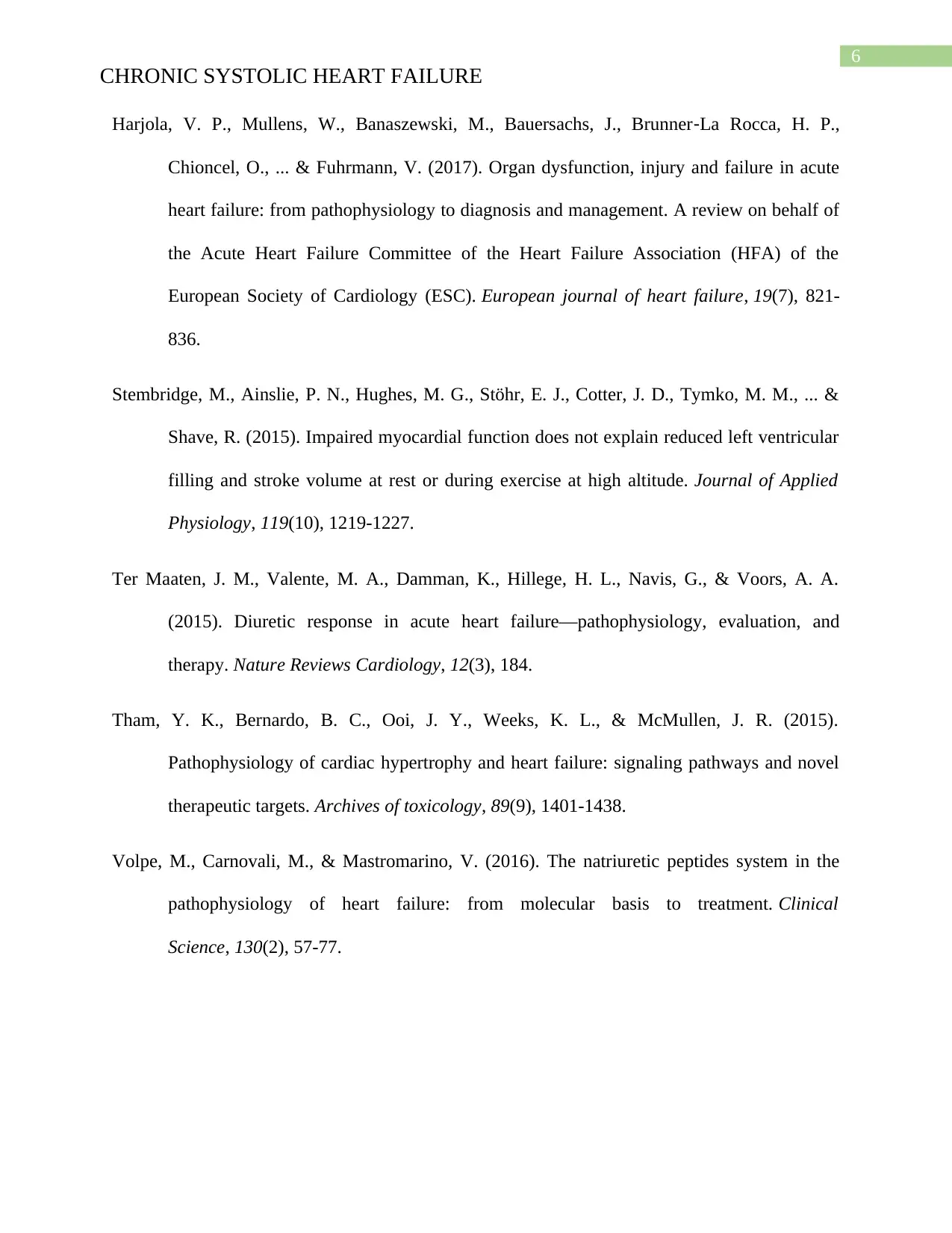
6
CHRONIC SYSTOLIC HEART FAILURE
Harjola, V. P., Mullens, W., Banaszewski, M., Bauersachs, J., Brunner‐La Rocca, H. P.,
Chioncel, O., ... & Fuhrmann, V. (2017). Organ dysfunction, injury and failure in acute
heart failure: from pathophysiology to diagnosis and management. A review on behalf of
the Acute Heart Failure Committee of the Heart Failure Association (HFA) of the
European Society of Cardiology (ESC). European journal of heart failure, 19(7), 821-
836.
Stembridge, M., Ainslie, P. N., Hughes, M. G., Stöhr, E. J., Cotter, J. D., Tymko, M. M., ... &
Shave, R. (2015). Impaired myocardial function does not explain reduced left ventricular
filling and stroke volume at rest or during exercise at high altitude. Journal of Applied
Physiology, 119(10), 1219-1227.
Ter Maaten, J. M., Valente, M. A., Damman, K., Hillege, H. L., Navis, G., & Voors, A. A.
(2015). Diuretic response in acute heart failure—pathophysiology, evaluation, and
therapy. Nature Reviews Cardiology, 12(3), 184.
Tham, Y. K., Bernardo, B. C., Ooi, J. Y., Weeks, K. L., & McMullen, J. R. (2015).
Pathophysiology of cardiac hypertrophy and heart failure: signaling pathways and novel
therapeutic targets. Archives of toxicology, 89(9), 1401-1438.
Volpe, M., Carnovali, M., & Mastromarino, V. (2016). The natriuretic peptides system in the
pathophysiology of heart failure: from molecular basis to treatment. Clinical
Science, 130(2), 57-77.
CHRONIC SYSTOLIC HEART FAILURE
Harjola, V. P., Mullens, W., Banaszewski, M., Bauersachs, J., Brunner‐La Rocca, H. P.,
Chioncel, O., ... & Fuhrmann, V. (2017). Organ dysfunction, injury and failure in acute
heart failure: from pathophysiology to diagnosis and management. A review on behalf of
the Acute Heart Failure Committee of the Heart Failure Association (HFA) of the
European Society of Cardiology (ESC). European journal of heart failure, 19(7), 821-
836.
Stembridge, M., Ainslie, P. N., Hughes, M. G., Stöhr, E. J., Cotter, J. D., Tymko, M. M., ... &
Shave, R. (2015). Impaired myocardial function does not explain reduced left ventricular
filling and stroke volume at rest or during exercise at high altitude. Journal of Applied
Physiology, 119(10), 1219-1227.
Ter Maaten, J. M., Valente, M. A., Damman, K., Hillege, H. L., Navis, G., & Voors, A. A.
(2015). Diuretic response in acute heart failure—pathophysiology, evaluation, and
therapy. Nature Reviews Cardiology, 12(3), 184.
Tham, Y. K., Bernardo, B. C., Ooi, J. Y., Weeks, K. L., & McMullen, J. R. (2015).
Pathophysiology of cardiac hypertrophy and heart failure: signaling pathways and novel
therapeutic targets. Archives of toxicology, 89(9), 1401-1438.
Volpe, M., Carnovali, M., & Mastromarino, V. (2016). The natriuretic peptides system in the
pathophysiology of heart failure: from molecular basis to treatment. Clinical
Science, 130(2), 57-77.
1 out of 7
Related Documents
Your All-in-One AI-Powered Toolkit for Academic Success.
+13062052269
info@desklib.com
Available 24*7 on WhatsApp / Email
![[object Object]](/_next/static/media/star-bottom.7253800d.svg)
Unlock your academic potential
Copyright © 2020–2025 A2Z Services. All Rights Reserved. Developed and managed by ZUCOL.





